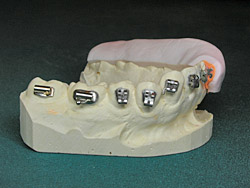Indirect Bonding
Life with Braces | Retention | Indirect Bonding | Emergency Care
 Traditional bracket placement involves the orthodontist hand placing each
bracket directly on the tooth. Accurate bracket placement directly in the mouth is very difficult
for even the most experienced orthodontist. Indirect bonding has been an exciting
advancement in orthodontics over the last 10 years. It has great benefit to
the patient as it improves patient comfort, reduces the amount of time in the
dental chair, improves the accuracy of bracket placement, and reduces overall
treatment time. Despite these advantages less than 10% of orthodontists routinely
practice indirect bonding. It requires a number of technically precise laboratory
procedures.
Traditional bracket placement involves the orthodontist hand placing each
bracket directly on the tooth. Accurate bracket placement directly in the mouth is very difficult
for even the most experienced orthodontist. Indirect bonding has been an exciting
advancement in orthodontics over the last 10 years. It has great benefit to
the patient as it improves patient comfort, reduces the amount of time in the
dental chair, improves the accuracy of bracket placement, and reduces overall
treatment time. Despite these advantages less than 10% of orthodontists routinely
practice indirect bonding. It requires a number of technically precise laboratory
procedures.
 To ensure accurate bracket placement and reduce treatment time,
our office employs a 100% indirect bonding technique when possible.
Rather than being placed directly in the mouth, our brackets are
mounted in the precise location on the patient’s treatment
models. A special tray is fabricated to transfer the brackets to
the patient’s teeth in the same precise location. This process
improves accurate bracket placement since the bracket alignment
can be viewed from several angles. The same visualization is not
possible working directly in the mouth.
To ensure accurate bracket placement and reduce treatment time,
our office employs a 100% indirect bonding technique when possible.
Rather than being placed directly in the mouth, our brackets are
mounted in the precise location on the patient’s treatment
models. A special tray is fabricated to transfer the brackets to
the patient’s teeth in the same precise location. This process
improves accurate bracket placement since the bracket alignment
can be viewed from several angles. The same visualization is not
possible working directly in the mouth.
Old fashioned bands on the teeth are generally unnecessary, if proper diet instructions are followed, even on the back teeth (molars). Bonded brackets are more comfortable, less irritating and healthier for the gums.



